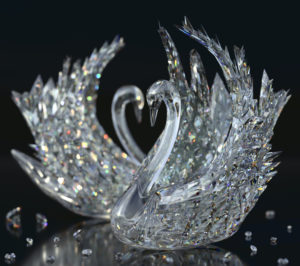
LuxCoreRender is a physically based and unbiased rendering engine based on state of the art algorithms. This allows it to accurately capture a wide range of phenomena which most other rendering programs are simply unable to reproduce.
Optimized rendering methods
LuxCoreRender features various render algorithms. Depending on the kind of scene and whether you’re rendering a single image or an animation, choosing the right algorithm can speed up rendering significantly. In simple scenes and exteriors, path tracing is usually sufficient. For interiors or caustic rendering, it can be augmented by additional light tracing and various caching systems. There are caches to accelerate the rendering of indirect light, caustics, environment light and scenes with many light sources. Furthermore, bidirectional path tracing combined with Metropolis sampling can be used to render the most complex lighting scenarios efficiently.
Materials & Textures
LuxCoreRender features a variety of material types. Apart from generic materials such as matte, glossy or the Disney principled shader, physically accurate representations of metal, glass, and car paint are present. All materials can be mixed and modified using textures, even recursively. LuxCoreRender supports both procedural textures and image textures (in common file formats, but also HDR). Most material properties are texturable, and all materials support bump and normal mapping.
Lighting
LuxCoreRender supports emitters and environment light sources. Photometric data in the form of IES diagrams can be used to accurately define the light distribution pattern of a light source. As environment light, one can use a HDR image, a physical sun/sky system, or use distant and infinte lamps as a generic sun and sky.
Light Groups
By using light groups, one can output various light situations from a single rendering, or make adjustments to the balance between light sources in real time during rendering, without losing the rendered samples. For each light source, intensity and color temperature can be adjusted on the fly. It is also possible to export the light contributions of each light group as separate passes, as either low or high dynamic range.
Volumes
LuxCoreRender includes a powerful volume system capable of physically accurate absorption and scattering. Absorption can be defined by RGB values, and scattering supports either single or multiple scattering with user-defined asymmetry. The volume system is object-based, using the mesh as the volume bounds. This allows simple setup for internal volumetric effects, such as subsurface scattering or volumetric color absorption. The system also allows you to define the volume a ray exits into as it leaves an object. This allows for atmospheric scattering effects, and automatic calculation of relative index of refraction. Additionally, a priority can be assigned to a volume so it replaces volumes with lower priority when volumes overlap.
Instances
When working on huge projects with multiple copies of the same object, LuxCoreRender’s support for instances will significantly save system resources, in particular memory consumption. If the same mesh is referenced by multiple objects, for example in the case of particles, it is only loaded into memory once.
Cameras
Apart from the ubiquitous perspective camera, LuxCoreRender supports orthographic and environment cameras. Using the orthographic camera, one can easily render a front or top view of a model, which can be very convenient for architects. The environment camera can be used to produce 360° panoramas or to produce HDR environment maps for image based lighting.
Motion Blur, Depth Of Field and Lens Effects
LuxCoreRender features true motion blur, both for the camera and individual objects. Just animate the camera or object, set the shutter time and you’re done. Object movement is described in absolute time rather than simply over the exposure time, allowing real-world control of shutter time and resulting blur strength. Multiple-steps for curved-trail blur is also supported. By setting parameters such as focus distance and f-stop, depth of field can be controlled. While your rendering is running, you can add post process effects like bloom, glare, chromatic aberration and vignetting, giving the image a final touch of photorealism.
Tone mapping
Internally, LuxCoreRender stores the result of all light calculations as high dynamic range values. Using either linear or non linear (Reinhard) tone mapping algorithms, these values can be converted to a ordinary low dynamic range image. This process can be influenced in real time, while a histogram aids in finding optimal settings. To minimize the amount of post processing after finishing the rendering, LuxCoreRender can save the output image in various color spaces and any gamma.
Cross-platform
LuxCoreRender is available for Windows, Linux and OS X.
License
LuxCoreRender is and will always be free software, both for private and commercial use. It is being developed by people with a passion for programming and for computer graphics who like sharing their work. LuxCoreRender is licensed under the Apache Public License v2.0 and free for both personal or commercial use.
